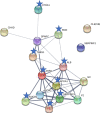Proteome Variation with Collagen Yield in Ancient Bone
- PMID: 33529527
- PMCID: PMC7944572
- DOI: 10.1021/acs.jproteome.0c01014
Proteome Variation with Collagen Yield in Ancient Bone
Abstract
Isotope analyses are some of the most common analytical methods applied to ancient bone, aiding the interpretation of past diets and chronology. For this, the evaluation of "collagen yield" (as defined in radiocarbon dating and stable isotope research) is a routine step that allows for the selection of specimens that are deemed adequate for subsequent analyses, with samples containing less than ∼1% "collagen yield" normally being used for isotopic analysis but discounted for radiocarbon dating. The aims of this study were to use proteomic methods of MALDI-TOF (matrix assisted laser desorption ionization time-of-fligh mass spectrometry) and LC-ESI-MS/MS (liquid chromatography electrospray ionization tandem mass spectrometry) to investigate the endogeneity of the dominant proteinaceous biomolecules within samples that are typically considered to contain poorly preserved protein. Taking 29 archaeological samples, we evaluated the proteome variability between different acid-soluble fractions removed prior to protein gelatinization and considered waste as part of the radiocarbon dating process. We then correlated these proteomes against the commonly used "collagen yield" proxy for preservation. We found that these waste fractions contained a significant amount of both collagenous and noncollagenous proteins (NCPs) but that the abundance of these was not correlated with the acquired "collagen yield". Rather than a depleted protein load as would be expected from a low "collagen yield", the variety of the extracted NCPs was comparable with that commonly obtained from ancient samples and included informative proteins useful for species identification, phylogenetic studies, and potentially even for isotopic analyses, given further method developments. Additionally, we did not observe any correlation between "collagen yield" and peptide mass fingerprint success or between the different fractions taken from the same sample but at different radiocarbon pretreatment stages. Overall, these findings highlight the value in retaining and analyzing sample fractions that are otherwise discarded as waste during the radiocarbon dating process but more importantly, that low "collagen yield" specimens that are often misinterpreted by archaeologists as being devoid of protein can still yield useful molecular sequence-based information.
Keywords: NCPs; ancient bone; collagen; proteomics; radiocarbon dating; stable isotopes.
Conflict of interest statement
The authors declare no competing financial interest.
Figures






References
-
- Ambrose S. H. Preparation and characterization of bone and tooth collagen for isotopic analysis. J. Archaeol. Sci. 1990, 17, 431–451. 10.1016/0305-4403(90)90007-r. - DOI
-
- Katzenberg M. A.. Stable isotope analysis: a tool for studying past diet, demography, and life history. Biological Anthropology of the Human Skeleton; Wiley, 2008; pp 411–441.
-
- Bearhop S.; Adams C. E.; Waldron S.; Fuller R. A.; MacLeod H. Determining trophic niche width: a novel approach using stable isotope analysis. J. Anim. Ecol. 2004, 73, 1007–1012. 10.1111/j.0021-8790.2004.00861.x. - DOI
-
- Fernandes R.; Jaouen K. Isotopes in archaeology. Archaeol. Anthropol. Sci. 2017, 9, 1305–1306. 10.1007/s12520-017-0507-4. - DOI
Publication types
MeSH terms
Substances
Grants and funding
LinkOut - more resources
Full Text Sources
Other Literature Sources
Miscellaneous

